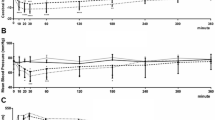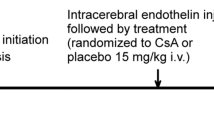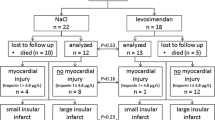Abstract
We investigated the neuroprotective action of nicotinamide in focal ischemia. Male spontaneously hypertensive rats (5–7 months old) were subjected to photothrombotic occlusion of the right distal middle cerebral artery (MCA). Either nicotinamide (125 or 250 mg/kg) or vehicle was injected IV before MCA occlusion. Changes in the cerebral blood flow (CBF) were monitored using laser-Doppler flowmetry, and infarct volumes were determined with TTC staining 3 days after MCA occlusion. In another set of experiments, the brain nicotinamide and nicotinamide adenine dinucleotide (NAD+) levels were analyzed by HPLC using the frozen samples dissected from the regions corresponding to the ischemic core and penumbra. In the 250-mg/kg nicotinamide group, the ischemic CBF was significantly increased compared to that the untreated group, and the infarct volumes were substantially attenuated (−36%). On the other hand, the ischemic CBF in the 125 mg/kg nicotinamide group was not significantly different from the untreated CBF, however, the infarct volumes were substantially attenuated (−38%). Cerebral ischemia per se did not affect the concentrations of nicotinamide and NAD+ both in the penumbra and ischemic core. In the nicotinamide groups, the brain nicotinamide levels increased significantly in all areas examined, and brain NAD+ levels increased in the penumbra but not in the ischemic core. Increased brain levels of nicotinamide are considered to be primarily important for neuroprotection against ischemia, and the protective action may be partly mediated through the increased NAD+ in the penumbra.
Similar content being viewed by others
REFERENCES
Zhang, J., Dawson, V. L., Dawson, T. M., and Snyder, S. H. 1994. Nitric oxide activation of poly (ADP-ribose) synthetase in neurotoxicity. Science 263:687-689.
Takahashi, K., Greenberg, J. H., Jackson, P., Maclin, K., and Zhang, J. 1997. Neuroprotective effects of inhibiting poly(ADP-ribose) synthetase on focal cerebral ischemia in rats. J. Cereb. Blood Flow Metab. 17:1137-1142.
Takahashi, K. and Greenberg, J. H. 1999 The effect of reperfusion on neuroprotection using an inhibitor of poly (ADP-ribose) polymerase. Neuroreport 10:2017-2022.
Takahashi, K., Pieper, A. A., Croul, S. E., Zhang, J., Snyder, S. H., and Greenberg, J. H. 1999. Post-treatment with an inhibitor of poly (ADP-ribose) polymerase attenuates cerebral damage in focal ischemia. Brain Res. 829:46-54.
Tokime, T., Nozaki, K., Sugino, T., Kikuchi, H., Hashimoto, N., and Ueda, K. 1998. Enhanced poly (ADP-ribosyl)ation after focal ischemia in rat brain. J. Cereb. Blood Flow Metab. 18:991-997.
Paschen, W., Olah, L., and Mies, G. 2000. Effect of transient focal ischemia of mouse brain on energy state and NAD levels: No evidence that NAD depletion plays a major role in secondary disturbances of energy metabolism. J. Neurochem. 75:1675-1680.
Lin, S.-H., Vincent, A., Shaw, T., Maynard, K. I., and Maiese, K. 2000. Prevention of nitric oxide-induced neuronal injury through the modulation of independent pathways of programmed cell death. J. Cereb. Blood Flow Metab. 20:1380-1391.
Ayoub, I. A., Lee, E. J., Ogilvy, C. S., Beal, M. F., and Maynard, K. I. 1999. Nicotinamide reduces infarction up to two hours after the onset of permanent focal cerebral ischemia in Wistar rats. Neurosci. Lett. 259:21-24.
Mokudai, T., Ayoub, I. A., Sakakibara, Y., Lee, E.-J., Ogilvy, C. S., and Maynard, K. I. 2000. Delayed treatment with nicotinamide (vitamin B3) improves neurological outcome and reduces infarct volume after transient focal cerebral ischemia in Wistar rats. Stroke 31:1679-1685.
Sakakibara, Y., Mitha, A. P., Ogilvy, C. S., and Maynard, K. I. 2000. Post-treatment with nicotinamide (vitamin B3) reduces the infarct volume following permanent focal cerebral ischemia in female Sprague-Dawley and Wistar rats. Neurosci. Lett. 281:111-114.
Huang, T. F. and Chao, C. C. 1960. The effect of niacinamide on cerebral circulation. Proc. Soc. Exp. Biol. Med. 105:551-553.
Cai, H., Yao, H., Ibayashi, S., Uchimura, H., and Fujishima, M. 1998. Photothrombotic middle cerebral artery occlusion in spontaneously hypertensive rats. Stroke 29:1982-1987.
Watson, B. D., Dietrich, W. D., Prado, R., Nakayama, H., Kanemitsu, H., Futrell, N., Yao, H., Markgraf, C. G., and Wester, P. 1995. Concepts and techniques of experimental stroke induced by cerebrovascular photothromobosis. Pages 169-194, in Ohnishi, S. T., Ohnishi, T. (eds.), Central nervous system trauma: Laboratory techniques and recent advancement, CRC Press, Boca Raton.
Yao, H., Ibayashi, S., Sugimori, H., Fujii, K., and Fujishima, M. 1996. Simplified model of krypton laser-induced thrombotic distal middle cerebral artery occlusion in spontaneously hypertensive rats. Stroke 27:333-336.
Yao, H., Takasawa, R., Fukuda, K., Shiokawa, D., Sadanaga-Akiyoshi, F., Ibayashi, S., Tanuma, S., and Uchimura, H. 2001. DNA fragmentation in ischemic core and penumbra in focal cerebral ischemia in rats. Mol. Brain Res. 91:112-118.
Rosen, G. D. and Harry, J. D. 1990. Brain volume estimation from serial section measurements: A comparison of methodologies. J. Neurosci. Methods 35:115-124.
Ponten, U., Ratcheson, R. A., Salford, L. G., and Siesjo, B. K. 1973. Optimal freezing conditions for cerebral metabolites in rats. J. Neurochem. 21:1127-1138.
Lowry, O. H., Rosenbrough, N. J., Farr, A. L., and Randall, R. J. 1951. Protein measurement with Folin phenol reagent. J. Biol. Chem. 193:265-275.
Andreoli, S. P. 1989. Mechanisms of endothelial cell ATP depletion after oxidant injury. Pediatr. Res. 25:97-101.
Shiokawa, D., Maruta, H., and Tanuma, S. 1997. Inhibitors of poly (ADP-ribose) polymerase suppress nuclear fragmentation and apoptotic-body formation during apoptosis in HL-60 cells. FEBS Lett. 413:99-103.
Eliasson, M. J. L., Sampei, K., Mandir, A. S., Hurn, P. D., Traystman, R. J., Bao, J., Pieper, A., Wang, Z.-Q., Dawson, T. M., Snyder, S. H., and Dawson, V. L. 1997. Poly (ADP-ribose) polymerase gene disruption renders mice resistant to cerebral ischemia. Nature Med. 3:1089-1095.
Endres, M., Wang, Z.-Q., Namura, S., Waeber, C., and Moskowitz, M. A. 1997. Ischemic brain injury is mediated by the activation of poly (ADP-ribose) polymerase. J. Cereb. Blood Flow Metab. 17:1143-1151.
Beal, M. F., Henshaw, D. R., Jenkins, B. G., Rosen, B. R., and Schulz, J. B. 1994. Coenzyme Q10 and nicotinamide block striatal lesions produced by the mitochondrial toxin malonate. Ann. Neurol. 36:882-888.
Hervias, I., Lasheras, B., and Aguirre, N. 2000. 2-Deoxy-D-glucose prevents and nicotinamide potentiates 3,4-methylene-dioxymethamphetamine-induced serotonin neurotoxicity. J. Neurochem. 75:982-990.
Kamat, J. P.and Devasagayam, T. P. A. 1999. Nicotinamide (vitamin B3) as an effective antioxidant against oxidative damage in rat brain mitochondria. Redox Rep. 4:179-184.
Klaidman, L. K., Mukherjee, S. K., Hutchin, T. P., and Adams, J. D. 1996. Nicotinamide as a precursor for NAD+ prevents apoptosis in the mouse brain induced by tertiary-butylhydroperoxide. Neurosci. Lett. 206:5-8.
LaPlaca, M. C., Raghupathi, R., Verma, A., Pieper, A. A., Saatman, K. E. Snyder, S. H., and McIntosh, T. K. 1999. Temporal patterns of poly (ADP-ribose) polymerase activation in the cortex following experimental brain injury in the rat. J. Neurochem. 73:205-213.
Wallis, R. A., Panizzon, K. L., and Girard, J. M. 1996. Traumatic neuroprotection with inhibitors of nitric oxide and ADP-ribosylation. Brain Res. 710:169-177.
Author information
Authors and Affiliations
Corresponding author
Rights and permissions
About this article
Cite this article
Sadanaga-Akiyoshi, F., Yao, H., Tanuma, Si. et al. Nicotinamide Attenuates Focal Ischemic Brain Injury in Rats: With Special Reference to Changes in Nicotinamide and NAD+ Levels in Ischemic Core and Penumbra. Neurochem Res 28, 1227–1234 (2003). https://doi.org/10.1023/A:1024236614015
Issue Date:
DOI: https://doi.org/10.1023/A:1024236614015




